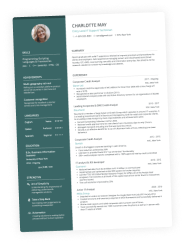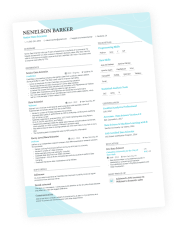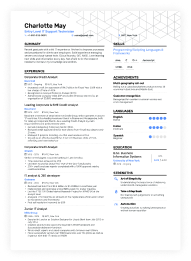Knowing how to address a cover letter correctly can be the difference between making a strong first impression—or getting ignored entirely. Yet for many job seekers, it’s one of the most frustrating parts of writing a cover letter. Should you use a name or a title, or should you just go with “Dear Hiring Manager”?
In this guide, we’ll walk you through how to address a cover letter in any situation—from finding the right hiring manager to using the best fallback options when names aren’t available. Whether you're applying to a corporate job, a startup, or through a referral, you’ll learn how to strike the right tone and avoid common mistakes.
Need help writing your cover letter from start to finish? Use our Cover Letter Generator or browse our professional cover letter templates to craft a personalized, polished letter—without the guesswork.
Key takeaways
- Always try to find a name: Check the job listing, company website, LinkedIn, or your personal network.
- Use a formal format: “Dear [Title] [Last Name]:” is the safest choice.
- No name? No problem: Use role- or department-based greetings like Dear Hiring Manager or Dear Marketing Team.
- Avoid outdated or casual greetings: Skip “To Whom It May Concern” and overly friendly openers like “Hi there.”
- Back it up with personalization: Even a generic greeting works if your letter is tailored to the job and company.
And while you're perfecting your cover letter, don’t forget your resume needs to match that same level of refinement.
Drop your resume here or choose a file.
PDF & DOCX only. Max 2MB file size.
Why getting the name right matters
Addressing your cover letter to the right person isn't just a formality—it sets a tone of professionalism and shows you’ve done your research. A personalized salutation increases the chances your letter will be read in full, especially in competitive industries. It signals you're not just mass-applying but genuinely interested in the role and the company.
Why it matters to recruiters and hiring managers:
- It demonstrates effort: Finding a name shows you care enough to research the company.
- It creates a connection: A direct address feels more engaging and human.
- It reflects your communication skills: Especially important for roles involving clients or cross-functional teams.
How to find the right person to address
Before you settle for a generic greeting, take a few minutes to try and find the name of the hiring manager or relevant contact. This extra effort can set your cover letter apart from dozens of others that begin with “Dear Hiring Manager.”
Where to look for the hiring manager’s name
- Job posting: Check for names in the job ad text or email addresses (e.g., j.doe@enhancv.com).
- Company website: Visit the “About Us” or “Team” pages to find department leads or HR staff.
- LinkedIn search: Search by job title and company name (e.g., “Software Engineer Manager at Acme Corp”).
- Company inquiry: Call or email the HR department or front desk to politely ask who is handling the role.
- Personal network: Reach out to friends, alumni, or mutual connections who might know someone inside.
Even if you can’t confirm who’s managing the hiring, identifying someone from the department can help you tailor your letter more effectively.
How to format the salutation if you have their name
Once you’ve found the name of the person reviewing your application, formatting your greeting properly is essential. It’s not just about etiquette—it signals professionalism, attention to detail, and genuine effort.
Standard format to follow
The most widely accepted and safest way to format your greeting, following standard cover letter format conventions in the U.S., is:
Dear [Title] [Last Name]:
Avoid using “Mrs.” unless the recipient has clearly indicated it. When in doubt, default to “Ms.” or skip the title entirely and use their full name.
How to avoid incorrect titles and assumptions
Before using “Mr.,” “Ms.,” or any other honorific, take a few moments to verify how the person identifies.
Here’s where to look:
- LinkedIn: Some users list their pronouns or are referred to in recommendations and comments.
- Company website bios: Team or leadership pages often describe the person in the third person (“she leads…”).
- Email signatures: If you’ve seen their contact info, it might include titles (e.g., “Dr. Sam Lee”).
If you can’t confirm gender or preferred titles, it’s safer to use the person’s full name without an honorific.
PRO TIP
Avoid assuming someone’s gender based on their name. When in doubt, do some research, or play it safe with a title-neutral option like “Dear Taylor Morgan”, “Dear Jordan Smith”, or “Dear Alex Lee”.
Avoid casual or outdated greetings
Starting your cover letter with greetings like “Hi Taylor,” or “To Whom It May Concern” can make your application feel rushed, generic, or outdated—especially in professional or formal industries.
Instead, use a respectful and modern format like the examples below.
Follows U.S. business etiquette and conveys the right level of formality:
Professional and respectful
Dear Ms. Patel:
Using the full name avoids assumptions while maintaining a professional tone:
Safe option when unsure about gender
Dear Taylor Morgan:
In the U.S., a colon (:) is standard at the end of a formal salutation—not a comma.
Correct: Dear Mr. Wilson:
Less formal: Dear Mr. Wilson,
Avoid: Hi John, or Hello
Use the colon to convey a professional tone, especially for traditional or corporate roles.
Smart alternatives if you don't have a name
Despite your best efforts, you won’t always be able to track down the name of the hiring manager—and that’s okay. What matters most is choosing a respectful fallback greeting that still feels relevant to the role.
Even without a name, your cover letter can sound intentional and personalized when the content speaks directly to the company and position.
Effective alternatives when no name is available
- Dear Hiring Manager:
The safest, most widely accepted fallback option. - Dear [Department] Hiring Manager:Personalizes the greeting slightly by referencing the team.
- Dear [Team Name] Team:
Works well when applying to collaborative teams or startups. - Dear [Job Title] Search Committee:
Common for academic, nonprofit, or leadership roles. - Dear Recruiter:
Acceptable when applying through a recruiter or external agency.
If the job description mentions the department (e.g., “You’ll work with the Content Team”), reflect that in your greeting. It shows you're paying attention—even without a name.
Even if your greeting isn’t specific, you can still show genuine effort in the body of your cover letter:
- Mention something unique about the company’s mission, culture, or recent projects.
- Align your experience directly with the job description.
- Refer to team or department names mentioned in the posting.
Hiring managers value personalized content far more than a perfectly addressed greeting—focus on making the rest of the letter count.
Not sure how all this looks in practice? Browse our collection of cover letter examples for different roles and industries.
Even with fallback greetings, some phrases are best left out entirely. Here’s what to avoid—and why.
Phrases to avoid in your greeting
| Phrase | Why to avoid it |
|---|---|
| To Whom It May Concern | Feels impersonal and outdated |
| Dear Sir or Madam | Gendered, formal to the point of stiffness |
| Hello / Hi there | Too casual for a professional application |
| No greeting at all | Misses a basic standard of professionalism |
How to address tricky situations
Not every cover letter situation fits neatly into a “with name” or “no name” category. If you’re applying through a referral, know the hiring manager personally, or are writing to a committee, you’ll need to adjust your greeting slightly.
Here’s how to strike the right balance between sounding too casual or too stiff.
When you know them personally
If you’ve worked with or met the hiring manager before, you might consider a more familiar greeting—but only if the tone of your relationship and the company culture support it.
Acceptable when you know the person well and are applying to a company with a casual culture:
Polished but friendly
Dear Taylor,
Even if you’re familiar with someone, it’s safer to keep things formal unless you’re absolutely sure a casual tone is appropriate.
When applying through a referral
Mention the person who referred you in the body of the letter—not in the greeting. If you can’t confirm who will read the letter, stick with:
Example
- Dear Hiring Manager,
- Dear [Department] Team,
- Or use the name of the person in charge, if available.
When writing to a committee or panel
Use collective terms when multiple decision-makers are involved:
Example
- Dear Search Committee:
- Dear [Job Title] Hiring Committee:
- Dear Selection Panel:
This is especially common in academia, nonprofits, and executive searches.
Conclusion
Getting the greeting right on your cover letter might seem like a small detail—but it’s one that hiring managers notice. A personalized salutation shows you’ve done your homework, while a well-chosen generic one still conveys effort and respect. No matter how you open, what truly matters is that your letter speaks directly to the role and company.
For help with structure, tone, and what to have beyond the greeting, read our guide on what to include in a cover letter. And once you’ve nailed the introduction, make sure your closing is just as strong—learn how in our guide on how to end a cover letter.




